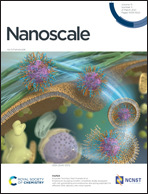Influence of stacking on the aqueous proton penetration behaviour across two-dimensional graphtetrayne†
Abstract
Two-dimensional (2D) graphtetrayne (G4) with intrinsic pattern triangular nanopores has been predicted to be an excellent candidate for next-generation proton exchange membranes due to its superior proton conductivity and selectivity. However, it is technically challenging to prepare a large area single-layer intact 2D material. A multi-layer stacked 2D material is a much more suitable choice, and the stacking can effectively shield the undesired defects and tears. In this work, we investigate the aqueous proton penetration behavior across multilayer-stacked two-dimensional G4 using extensive ReaxFF molecular dynamics simulations. We found that the G4 layers prefer a slightly misplaced stacking pattern which would cause only a slight reduction in the pore size. Detailed analyses indicate that the “water wires” across G4 remain continuous and can provide a low-barrier path for proton penetration until the number of stacking layers increases to three. In triple-layer G4, the “water wires” no longer exist and the aqueous phase will be separated by a wide vacuum area, thus significantly impeding the proton penetration behavior. Based on these results, we suggest that when serving as a proton exchange membrane, the number of stacking G4 layers should be fewer than three to achieve satisfactory conductivity. Our work provides guidance for the fabrication of next-generation proton exchange membranes based on nanoporous 2D materials.



 Please wait while we load your content...
Please wait while we load your content...